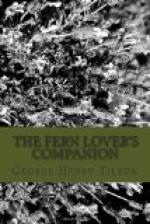Stipe long and brittle. Fronds oblong-lanceolate, five to twelve inches long, twice pinnate, the pinnae often pinnatifid or cut-toothed, ovate-lanceolate, decurrent on the winged rachis. Indusium appearing acute at the free end. Very variable in the cutting of the pinnules.
The fragile bladder fern, as it is often called, and which the name fragilis suggests, is the earliest to appear in the spring, and the first to disappear, as by the end of July it has discharged its spores and withered away. Often, however, a new crop springs up by the last of August, as if Nature were renewing her youth. In outline the fragile bladder fern suggests the blunt-lobed Woodsia, but in the latter the pinnae and pinnules are usually broader and blunter, and its indusium splits into jagged lobes. Rather common in damp, shady places where rocks abound. In one form or another, found nearly throughout the world though only on mountains in the tropics.
[Illustration: Fragile Bladder Fern, Fruited Portion]
[Illustration: Fragile Bladder Fern. Cystopteris fragilis (Wakefield, Mass.)]
KEY TO THE WOODSIAS
Stipes not jointed:
Indusium ample, segments broad,
frond without hairs.
Obtuse
Woodsia.
Pinnae hispidulous, with white
jointed hairs beneath.
Rocky
Mountain Woodsia.
Fronds bright green, pinnae
glabrous, oblong.
Oregon
Woodsia.
Fronds dull green, lanceolate,
glandular beneath.
Cathcart’s
Woodsia.
Stipes obscurely jointed near the base:
Fronds more or less chaffy,
pinnae oblong to ovate,
crowded.
Rusty Woodsia.
Fronds linear, smooth, pinnae
deltoid or orbicular.
Smooth
Woodsia.
Fronds lanceolate, a few white
scales beneath; pinnae
deltoid-ovate.
Alpine Woodsia.
THE WOODSIAS
Small, tufted, pinnately divided ferns. Fruit-dots borne on the back of simply forked, free veins. Indusium fixed beneath the sori, thin and often evanescent, either small and open, or early bursting at the top into irregular pieces or lobes. (Named for James Woods, an English botanist.)
(1) RUSTY WOODSIA. Woodsia ilvensis
Fronds oblong-lanceolate, three to ten inches high, rather smooth above, thickly clothed underneath with rusty, bristle-like chaff. Pinnate, the pinnae crowded, sessile, cut into oblong segments. Fruit-dots near the margin often confluent at maturity. Indusium divided nearly in the center into slender hairs which are curled over the sporangia. Stipes jointed an inch or so above the rootstock.




